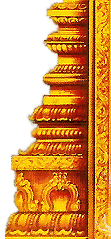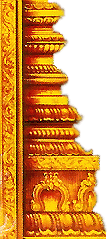The temple’s beauty and reputation lies in the majestic form of Mother Sree Durga in the northern corridor (prakara) of the temple. Speaking volumes of the skill of the sculptor, Mother Durga graces from under a stone umbrella, standing on the head of a buffalo holding weapons as conch, discus, sword, bow, club, trident, armour, angusam the rope. Two men are approaching Her, one chopping his own head and other tearing his lap offering blood sacrifice. While the Goddess is holding theis Lotus Feet is head,, bow in one hand, the other hand assures safety with her ring finger touching the thumb, other fingers straight, a sign called chinmudra. A basket with arrows is at Her back.
It is said that the Durga idols of Tirupullamangai temple and those in Tirunageswaram and Patteeswaram were made by the same sculptor, all having supreme powers.
There are shrines for Chandeswara, Navagrahas the nine planets with Nandhi at the centre and Nalvar – Ganasambandar, Tirunavukkarasar, Sundarar and Manickavasagar. Eagles are ever flying on the top of the tower. This is the place where Lord Shiva made nectar of Aalahala poison that came out of the milk ocean. The sanctum sanctorum is of Agazhi type – Agazhi is a deep water canal security arrangement around a fort with crocodiles put in to prevent enemies entry to the fort.
We witness devastating floods even today despite preventive dam arrangements. In those days, when such engineering safety was not available, many of the Cauvery delta villages were ruined due to heavy floods. These natural calamities are recorded in Tirukattupalli epigraphic details of Sundara Cholan period.
Parandaka Cholan, the great grandfather of Rajaraja Cholan had renovated this temple in Tirupullamangai and other one in Pasupatheeswaram, as found in the stone carvings in pillars. Many of the sculptures as pillars and other temple structures and idols as Chandikeswara, Chamunda Devi on the eastern side of the temple, Jeshta Devi and Nandi represent the Chola period. In later years, rulers of north not only invaded this region but also had robbed invalauable art wealth.
These temples were later renovated by Vijayanagara ruler Veera Sumbanna Udayar with sanctions of land for temple maintenance. He also built the five tier main tower – Rajagopuram 65 feet tall that contains a mention in Telugu of this work representing Naicker architecture.
The then Thanjavur Maratta king Prataba Simhan, who was paying tax to the Arcot Nawab delayed the payment once. Exasperated, the Nawab, invaded Thanjavur twice. The second army of the Nawab Anwaruddin camped near the Pasupathikoil village and began attacking the temple with a tanker. In retaliation, king’s commander Manojiappa gave a fitting fight and defeated the Nawab and captured him.
Thus the place and Pasupatheeswarar temple were subjected to successive calamities and was renovated by the King Pratapasimhan. One can find a mix of Cholas, Naicker and Maratta cultures in the temple now. After the days of kings were over, there was none to take care of the temple and its maintenance leading to its poor condition. Many beautiful sculptures had been robbed and there is no trace of them. The first corridor (prakara) was almost floored off. The Goddess and Her shrine were almost destroyed. Bats were flying.
The temple is built in accordance with the Agama rules in the north eastern corner (called Eesanya corner) in the Kallar Pasupathikoil village.
The 65 feet tall main tower (Rajagopuram) is very beautiful at the entrance. There are facilities to climb the tower. A Nandhi of the Chola period is on the western side under the Madakoil in a sitting form with its legs folded. Some sculptures are available here and there. |





